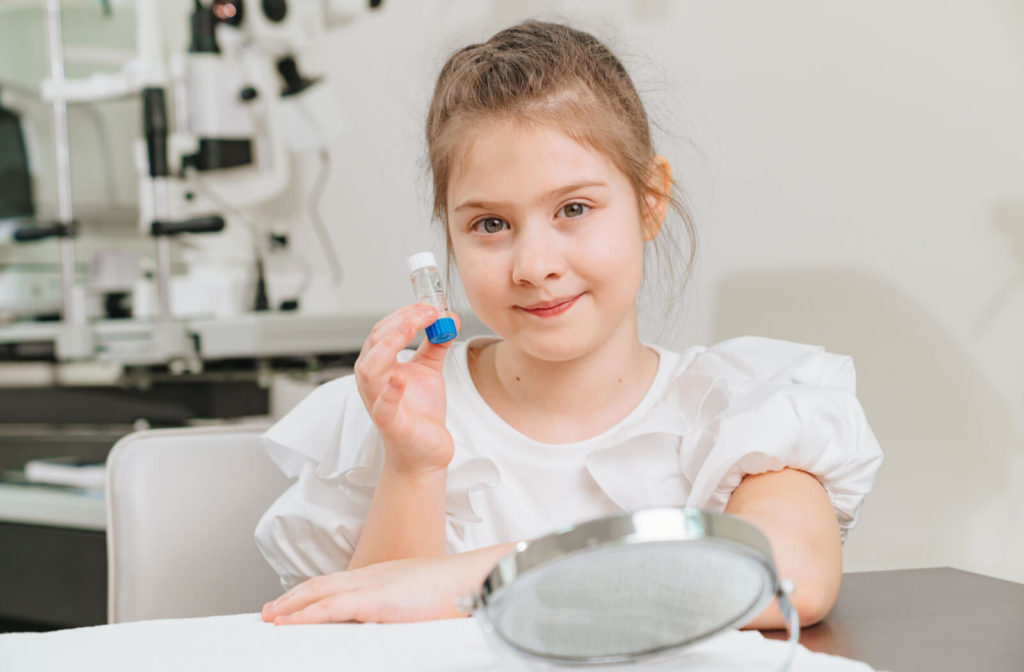Myopia or nearsightedness, as the name suggests, is when you can see close-up objects clearly. However, because the light entering the eye focuses before it reaches the retina instead of on it, objects farther away appear blurry.
An estimated 30% of Canadians are myopic. Apart from the increase in numbers, myopia is also occurring at earlier ages and progressing faster. Unfortunately, there is no cure for myopia and it is not reversible.
Eye development in young children continues as they grow. To ensure they meet visual developmental milestones, the Canadian Association of Optometrists recommends regular children’s eye exams.
While childhood myopia isn’t reversible, there are ways to manage the condition and slow its progression. Keep reading as we discuss the causes and risks of developing myopia, its symptoms, and how to control and manage this eye condition.
Causes of Myopia
Myopia results from abnormal eye shape where the eyeball is too long or the cornea (the clear outer layer) too steep. Because of this, the light can’t focus directly on the retina at the back of the eye.
Depending on the length of the eye and the speed of growth, you can experience the following forms of myopia:
High Myopia
High myopia is a severe form of the condition. In high myopia, the eyeball continues to grow from front to back. This results in blurry distant vision and a higher risk of developing other conditions, such as glaucoma, cataracts, and detached retina.
Degenerative Myopia
This type is linked to a family history of myopia and is usually inherited from your parents. The eyeball grows longer at a faster rate and leads to severe myopia by the early adult years. With degenerative myopia, there is a high risk of developing glaucoma, detached retina, and abnormal blood vessel growth in the eye.
Your Risk of Developing Myopia
Myopia can develop in anyone. But here are some factors that can increase your risk of developing myopia:
- Family history: Your risk of developing myopia is high if you have one parent who is nearsighted and even higher if both parents are nearsighted.
- Near-focus work: Long periods of doing close-up work such as reading, using a computer, or in front of digital devices are associated with a higher risk of developing myopia.
- Environmental factors: Not spending enough time outdoors can increase your risk.
Myopia Symptoms
Symptoms of myopia can affect your ability to learn, perform tasks, and enjoy activities. Signs and symptoms of myopia include:
- Blurry vision
- Squinting
- Headaches
- Eye strain
- Eye fatigue
- Excessive rubbing and blinking
- Trouble seeing the board at school
- Difficulty driving at night

Treating Myopia & Controlling Progression
Myopia is a progressive eye condition that typically starts in childhood and worsens until the late teens and early twenties.
Between ages 20 and 40, the condition typically stabilizes with little to no change. However, if it’s not corrected, changes in the eye can lead to glaucoma, cataracts, and a detached retina.
Treatments for myopia include prescription eyeglasses and contact lenses to correct vision. Adults can opt for refractive surgery, which involves using a laser to reshape the cornea to refract light correctly.
In childhood myopia, where the condition continues to progress, the following myopia control methods can provide solutions to slow progression:
MiSight Contact Lenses
These soft contact lenses, specially made for children, provide clear vision at all distances and can slow myopia progression. MiSight contact lenses prevent the axial length of the eye from growing longer to preserve distance vision in adulthood.
MiyoSmart Eyeglass Lenses
These eyeglass lenses work similarly to MiSight contact lenses to slow myopia progression. They are comfortable, easy to use, and suitable for children who can’t wear contact lenses.
Atropine Drops
Low-dose atropine drops can help slow myopia progression caused by long periods of near-focus work. Atropine drops temporarily paralyze the eye’s focus muscles and relax them.
Orthokeratology
Orthokeratology, or Ortho-K, uses rigid contact lenses that temporarily reshape or flatten the cornea. They are mostly worn at night and removed during the day and can provide clear vision without the need for glasses.
Orthokeratology can help reduce myopia progression. Results aren’t permanent, though. If you stop wearing these contact lenses, the cornea can revert to its original shape.
Treatment Solutions for Myopia Control
In childhood myopia, with age comes the normal progression of the condition. Most cases of myopia can be slowed and even prevented, but not reversed.
However, with several control and management strategies, the team at Dr. Zargar Eyecare can help preserve your vision. If you notice changes, book an appointment to have your eyes examined.

